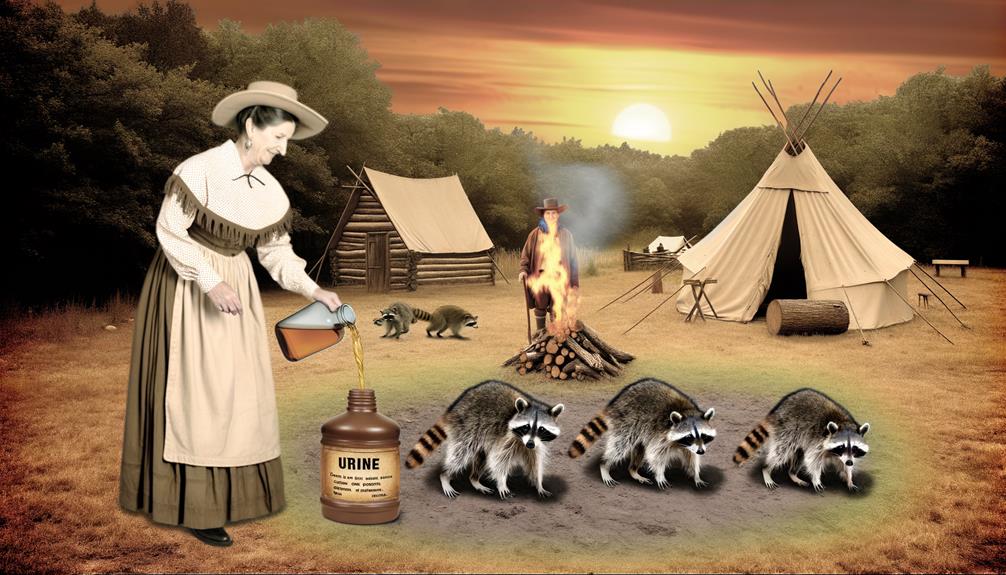How Does Human Urine Repel Raccoons?
Human pee has been historically used as a raccoon repellent with mixed results. It mainly contains urea and ammonia, compounds that theoretically could deter raccoons due to their strong scent.
While some anecdotal evidence suggests temporary avoidance behavior in raccoons, scientific studies provide inconclusive results, showing variability based on environmental factors and application methods. Practical evidence indicates that frequency of application and placement are pivotal.
Despite its accessibility, human urine's effectiveness remains inconsistent compared to other deterrent methods. Evaluating the diverse results sheds light on its practicality and possible integration into broader deterrent strategies.

Key Takeaways
- Human urine may temporarily deter raccoons due to its strong scent and ammonia content.
- Effectiveness varies; some studies show avoidance, while others report inconsistent results.
- Anecdotal evidence suggests reduced raccoon activity in urine-treated areas.
- Application frequency, concentration, and placement impact the effectiveness of urine as a deterrent.
- Alternative deterrents like chemical repellents and physical barriers may provide more consistent results.
Historical Background

Historically, the use of human urine as a repellent for raccoons can be traced back to anecdotal practices among rural communities seeking natural deterrents. Reports from the early 20th century document individuals utilizing urine in attempts to protect crops and livestock.
Despite limited empirical evidence, the practice persisted due to its perceived effectiveness and accessibility. Early studies, though sparse, hinted at the potential of human urine to deter certain wildlife, owing to its strong odor and presence of compounds such as urea and ammonia.
However, thorough scientific validation remained elusive. Modern investigations are still examining the chemical interactions and behavioral responses of raccoons to human urine, aiming to quantify its efficacy systematically. This historical context underscores the need for rigorous research in wildlife management.
Understanding Raccoon Behavior
Understanding raccoon behavior requires a thorough examination of their foraging patterns, social structures, and environmental interactions.
Raccoons are nocturnal omnivores, exhibiting opportunistic foraging strategies, often scavenging in urban and suburban areas.
Socially, they are generally solitary but may form groups called 'nursery groups' comprising females and their young.
Their adaptability to diverse habitats is evident in their utilization of human-made structures for shelter.
Research indicates that raccoons possess acute olfactory senses, enabling them to detect food and potential threats with precision.
Their territorial markings and scent-based communication play significant roles in individual and group behavior.
Understanding these behavioral traits is critical for evaluating any potential deterrents, including the hypothesis that human urine might repel raccoons.
Composition of Human Urine

Human urine is composed primarily of urea and ammonia, which are nitrogenous waste products. Additionally, it contains various hormones and pheromones that can influence animal behavior, as well as salts and minerals that contribute to its chemical profile.
Analyzing this composition is essential for understanding its potential impact on raccoons.
Urea and Ammonia Content
The primary components of human urine, urea and ammonia, play a critical role in its chemical composition and potential repellant properties against raccoons. Urea, a nitrogenous compound, is the main waste product of protein metabolism. Ammonia, a byproduct of urea decomposition, contributes to the characteristic odor of urine, which may deter raccoons. The concentration of these compounds can vary based on diet, hydration, and health status, influencing their effectiveness as repellents.
| Compound | Average Concentration | Potential Repellent Effect |
|---|---|---|
| Urea | 9.3 g/L | High due to nitrogen content |
| Ammonia | 0.05 g/L | Moderate due to strong odor |
| Creatinine | 1.5 g/L | Low |
| Sodium | 1.4 g/L | Negligible |
| Chloride | 1.87 g/L | Negligible |
This data-driven approach aids in understanding how these components might influence raccoon behavior.
Hormones and Pheromones
In addition to urea and ammonia, human urine contains a variety of hormones and pheromones that may also influence raccoon behavior. These biochemical compounds can serve as chemical signals, potentially altering the behavior of wildlife.
Key hormones and pheromones present in human urine include:
- Epinephrine: Known as adrenaline, it can affect the stress response in animals.
- Cortisol: Another stress-related hormone that may signal the presence of predators.
- Testosterone: This hormone could mark territorial boundaries, influencing animal movement.
- Estrone: A type of estrogen that may affect reproductive behaviors.
The presence of these hormones and pheromones could potentially deter raccoons or alter their activity patterns, though further empirical studies are necessary to validate these effects conclusively.
Salts and Minerals
Urine contains a variety of salts and minerals, including sodium, potassium, chloride, and calcium, which play essential roles in maintaining homeostasis. Sodium and chloride are critical for regulating fluid balance and blood pressure, while potassium is necessary for muscle function and nerve signaling. Calcium contributes to bone health and various enzymatic processes.
These electrolytes are excreted in urine as the body maintains ideal internal conditions. The concentrations of these salts and minerals can vary based on diet, hydration levels, and overall health. Understanding the composition of human urine is fundamental when investigating its potential effects on wildlife behavior, such as whether it can serve as a repellent for raccoons.
Quantitative analysis of these components can provide insights into any aversive properties.
Scientific Studies
Multiple peer-reviewed studies have examined the efficacy of human urine as a raccoon deterrent, yielding mixed results.
- Olfactory Response: Research indicates that raccoons have a highly developed sense of smell, but their reaction to human urine varies notably.
- Behavioral Studies: Some studies observed temporary avoidance behavior in raccoons when exposed to human urine, suggesting a potential deterrent effect.
- Controlled Experiments: Experiments conducted in controlled environments showed inconsistent outcomes, with some raccoons showing no aversion.
- Field Studies: Field-based investigations demonstrated that environmental factors, such as food availability and habitat, notably influence the effectiveness of human urine as a repellent.
Anecdotal Evidence

Numerous personal experiences and observations from gardeners suggest that human urine may act as a raccoon deterrent. These anecdotal accounts, while not scientifically validated, highlight recurring themes of reduced raccoon activity in areas treated with human urine.
Further systematic investigation is necessary to substantiate these claims and understand the mechanisms involved.
Personal Experiences Shared
Several individuals have reported success using human urine as a deterrent to raccoons, providing anecdotal evidence that suggests its potential effectiveness. These personal experiences highlight various strategies and outcomes:
- Frequency of Application: Some individuals noted that frequent application, particularly around garbage bins, yielded better results.
- Location: Urine was often applied to the perimeter of gardens and near entry points to deter raccoons.
- Concentration: Higher concentrations of urine appeared to be more effective, suggesting a correlation between potency and deterrence.
- Combination Methods: Combining human urine with other deterrents, such as motion-activated lights, was reported to enhance effectiveness.
While these accounts provide practical insights, further empirical studies are necessary to validate these observations and establish concrete guidelines.
Observations From Gardeners
Drawing from the experiences of various gardeners, anecdotal evidence suggests that human urine may serve as an effective raccoon deterrent, particularly when applied strategically around vulnerable areas. Gardeners have reported mixed results, with some noting a significant reduction in raccoon activity, while others observed minimal impact.
| Observation Type | Reported Effectiveness |
|---|---|
| Suburban Gardens | High |
| Urban Gardens | Moderate |
| Rural Gardens | Low |
| Community Gardens | Variable |
These subjective accounts provide valuable insights but lack the rigorous controls of scientific studies. The variability in effectiveness may be influenced by factors such as the concentration of urine, application frequency, and local raccoon populations. Further empirical research is required to substantiate these anecdotal observations.
Pros and Cons
Evaluating the pros and cons of using human urine as a raccoon repellent involves considering both the potential effectiveness and the associated implications for health, safety, and environmental impact.
Pros:
- Readily Available: Human urine is easily accessible and cost-free.
- Chemical-Free: Unlike commercial repellents, urine does not contain synthetic chemicals.
Cons:
- Variable Efficacy: Evidence on its effectiveness is largely anecdotal and not scientifically validated.
- Health Concerns: Potential health hazards due to pathogens present in urine.
This balanced approach helps in understanding whether human urine is a viable option for raccoon repellent, taking into account the practical benefits and the potential drawbacks.
Such a nuanced perspective aids in informed decision-making for individuals considering this method.
Practical Application Tips

To maximize the potential effectiveness of human urine as a raccoon repellent, it is essential to take into account specific application techniques and environmental factors. Frequency of application, placement, and urine concentration are critical variables. Below is a table summarizing these factors:
| Factor | Description | Considerations |
|---|---|---|
| Frequency | How often urine is applied | Weekly application recommended |
| Placement | Locations where urine is distributed | Near entry points and perimeter |
| Concentration | Dilution level of the urine | Higher concentrations yield better results |
| Weather Conditions | Impact of rain and wind on urine efficacy | Reapply after heavy rain or strong winds |
| Human Presence | Deterrence effect augmented by human activity | More effective with regular human presence |
Understanding these dynamics can enhance the deterrent effect, contributing to a more raccoon-free environment.
Alternative Deterrents
Numerous alternative deterrents have been investigated for their efficacy in repelling raccoons, each leveraging different sensory mechanisms and environmental adaptations. These methods have shown varying degrees of success, often contingent on specific conditions and raccoon behavior.
Key alternatives include:
- Chemical Repellents: Substances like ammonia and predator urine mimic natural threats, exploiting raccoons' olfactory sensitivity.
- Ultrasonic Devices: Emitting high-frequency sounds, these tools aim to create an inhospitable environment for raccoons.
- Physical Barriers: Fencing and netting provide a physical deterrent, preventing access to vulnerable areas.
- Light and Sound Deterrents: Motion-activated lights and noise devices startle raccoons, utilizing their aversion to sudden sensory changes.
These methods underscore the importance of a multifaceted approach to raccoon management.
Conclusion
The theory that human urine repels raccoons remains inconclusive. While some anecdotal evidence suggests efficacy, scientific studies are limited and do not robustly support this claim.
The composition of human urine may contain elements perceived as threats by raccoons, yet consistent empirical data is lacking. Further research is necessary to substantiate these observations.
Until then, alternative deterrents with proven effectiveness should be considered for managing raccoon presence.






